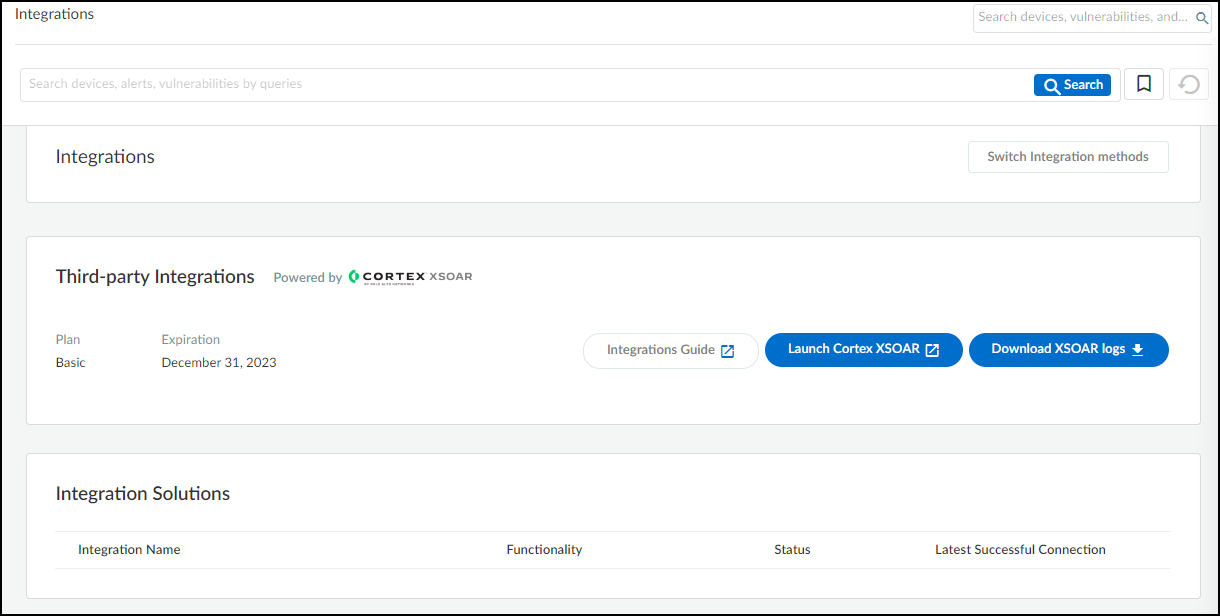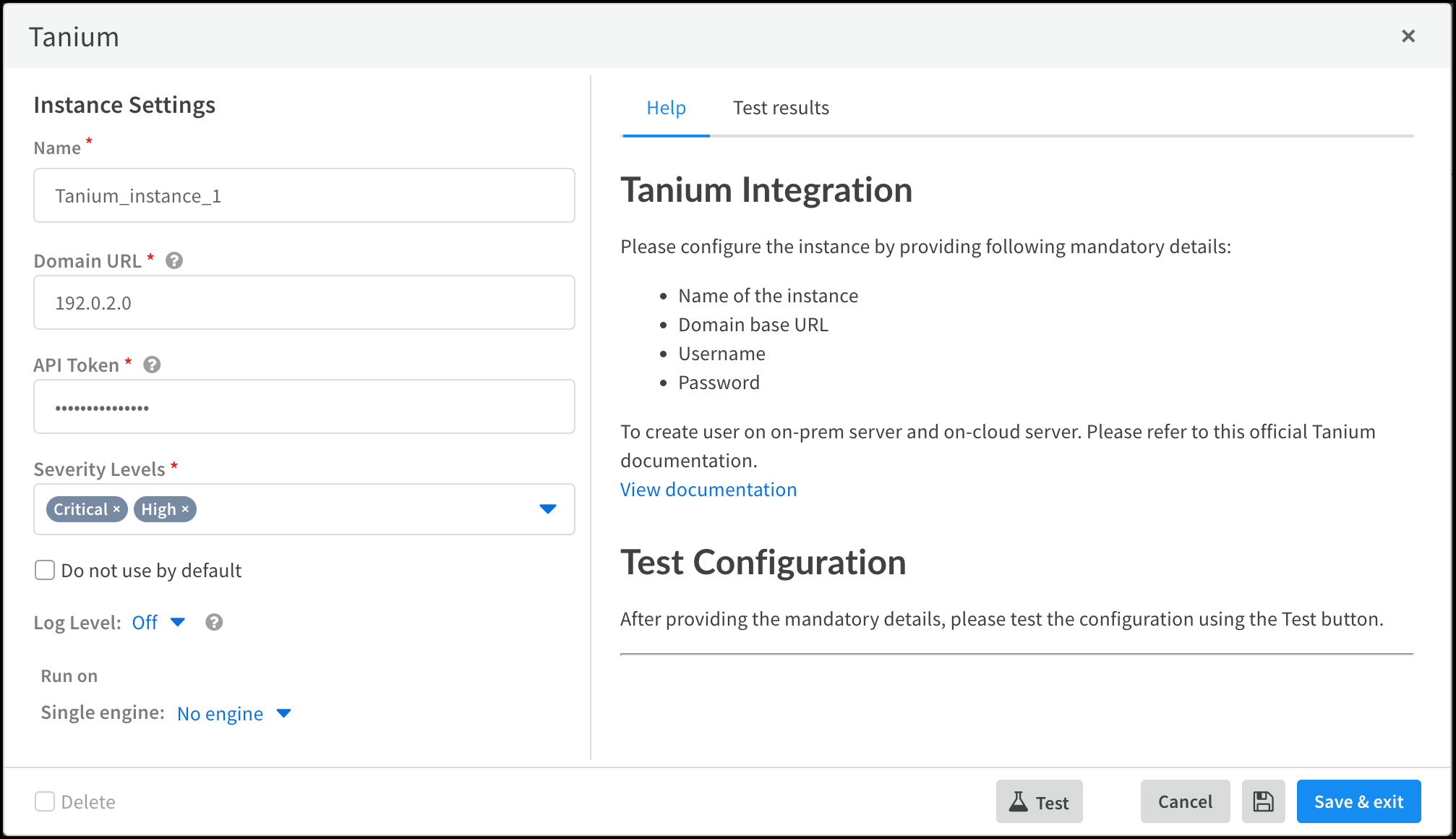Device Security
Set up Device Security and XSOAR for Tanium Integration
Table of Contents
Expand All
|
Collapse All
Device Security Docs
Set up Device Security and XSOAR for Tanium Integration
Set up Device Security and Cortex XSOAR to integrate with Tanium.
| Where Can I Use This? | What Do I Need? |
|---|---|
|
One of the following subscriptions:
One of the following Cortex XSOAR setups:
|
To set up Device Security to integrate through Cortex XSOAR with Tanium, configure XSOAR
with a Tanium integration instance and a job to import device details and
vulnerabilities. You can set the job to run at regular intervals or on demand. The
configuration requires the following information from Tanium:
- Domain URL of a cloud-hosted Tanium server, or an FQDN or IP address of an on-premises Tanium server
- Username and password of the user account that XSOAR uses when connecting to the Tanium API
To set up Device Security to integrate through a cloud-hosted Cortex XSOAR instance with
an on-premises Tanium server, you must also add a Cortex XSOAR engine to your
network.
Cortex XSOAR Engine Installation
An on-premises XSOAR engine facilitates communications between the
Cortex XSOAR cloud and an on-premises Tanium server. Although it's possible to
install an Cortex XSOAR engine on machines running Windows, macOS, and Linux
operating systems, only an engine on a Linux machine supports Device Security
integrations. For more information about operating system and hardware requirements
for Cortex XSOAR, see the
Administrator's Guide.
We recommend downloading the Cortex XSOAR engine using the shell
installer script and installing it on a Linux machine. This simplifies the
deployment by automatically installing all required dependencies and also
enables remote engine upgrades.
When placing the XSOAR engine on your network, make sure it can form HTTPS connections
to your on-premises Tanium server. By default, HTTPS uses TCP port 443.
The on-premises firewall must allow the Cortex XSOAR engine to form
HTTPS connections on TCP port 443 to the Cortex cloud at
https://<your-domain>.iot.demisto.live/. You can see the URL of your
Cortex XSOAR instance when you log in to Device Security
and click Integrations and then click Launch
Cortex XSOAR. It’s visible in the address bar
of the web page displaying the Cortex XSOAR interface.
To create an Cortex XSOAR engine, access the Cortex XSOAR
interface (from Device Security, click
Integrations and then click Launch
Cortex XSOAR). In the Cortex XSOAR UI,
click SettingsEngines+ Create New Engine. Choose
Shell as the type.
For Cortex XSOAR engine installation instructions, see Engine Installation.
For help troubleshooting Cortex XSOAR engines, including installations,
upgrades, connectivity, and permissions, see Troubleshoot Engines and Troubleshoot Integrations Running on
Engines.
Configure Device Security and Cortex XSOAR
- Log in to Device Security and from there access Tanium settings in Cortex XSOAR.
- Log in to Device Security and then click
Integrations.
![]()
- Device Security uses Cortex XSOAR to integrate with Tanium, and the settings you must configure to integrate with it are in the XSOAR interface. To access these settings, click Launch Cortex XSOAR.The Cortex XSOAR interface opens in a new browser window.
- Click Settings in the left navigation menu, search for tanium to locate it among other instances.
![]()
Configure the Tanium integration instance.- Click Add instance to open the settings panel.
- Enter the following settings:Name: Use the default name of the instance or enter a new one.Remember the instance name because you are going to use it again when creating a job that Cortex XSOAR will run to gather data from the Tanium instance specified in this integration instance.Domain URL: Enter the domain URL of a cloud-hosted Tanium instance or static IP address of an on-premises Tanium server. Note that you can include or omit https:// from the URL. Both of these formats are acceptable:
- https://<customername>-api.cloud.tanium.com
- <customername>-api.cloud.tanium.com
Username: Type the name of the user account that you previously created for the XSOAR engine to use when connecting to the Tanium API.Password: Type the password associated with the user account.Use single engine: When using a cloud-based XSOAR instance and an on-premises Tanium server, choose the XSOAR engine that you want to communicate with the Tanium server.![]()
- When finished, click Run test or Test.If the test is successful, a Success message appears. If not, check that the settings were entered correctly and then test the configuration again.
![]()
- After the test succeeds, click Save & exit to save your changes and close the settings panel.
To integrate with other Tanium servers, repeat the previous steps to add more integration instances.Create a job for XSOAR to query Tanium for device vulnerabilities and import them to Device Security.Device Security only imports vulnerabilities for devices that are already in its database and whose MAC address matches that Tanium returns. If Tanium returns vulnerabilities for MAC addresses that aren’t in the Device Security database, they’re ignored and dropped.- Copy the name of the instance you just created, click Jobs near the bottom of the left navigation menu and then click New Job at the top of the page.
- In the New Job panel that appears, enter the following and leave the other settings at their default values:Recurring: Select this if you want to periodically import vulnerabilities from Tanium. Clear it if you want to import them on demand.Every: If you select Recurring, enter a number and set the interval value (Minutes, Hours, Days, or Weeks) and select the days on which to run the job. (If you don’t select specific days, then the job will run everyday by default.) This determines how often XSOAR queries Tanium for device vulnerabilities. For example, every day at 2:00 AM.Name: Enter a name for the job.Playbook: Choose Import Tanium Vulnerabilities to PANW IoT cloud.Integration Instance Name: Paste the instance name you copied a few moments ago.Import vulnerabilities by CVE severity levels: Choose one or more severity levels to determine which vulnerabilities to import: Critical, High, Medium, Low, or Unscored (that is, there is no severity score). Choosing all five severities is the same as not choosing any.The severity levels are based on Common Vulnerability Scoring System version 3 (CVSSv3).
- Click Create new job.
Enable the job and run it.- Check the Job Status for the job you created. If it’s Disabled, select its check box and then click Enable.
- After you enable it, keep the check box selected and click Run now. The Run Status changes from Idle to Running.If you selected Recurring, XSOAR queries Tanium for device vulnerabilities at the defined interval and forwards imported information to Device Security.If you cleared Recurring, XSOAR immediately queries Tanium and forwards imported device vulnerabilities to Device Security.
If you created more integration instances for multiple on-premises Tanium servers, add more jobs as necessary.An integration instance can be in one of the following four states, which Device Security displays in the Status column on the Integrations page:- Active — the integration was configured and enabled and is functioning properly.Disabled — either the integration was configured but intentionally disabled or it was never configured and a job that references it is enabled and running.
- Error — the integration was configured and enabled but is not functioning properly, possibly due to a configuration error or network condition.
- Inactive — the integration was configured and enabled but no job has run for at least the past 60 minutes.
When you see that the status of an integration instance is Active, its setup is complete. - Log in to Device Security and then click
Integrations.




